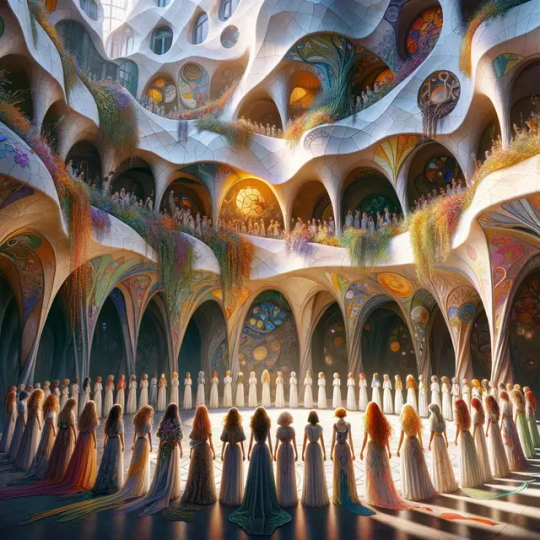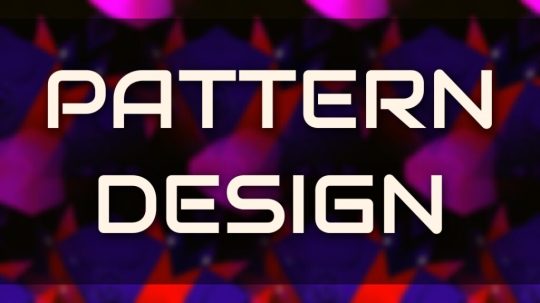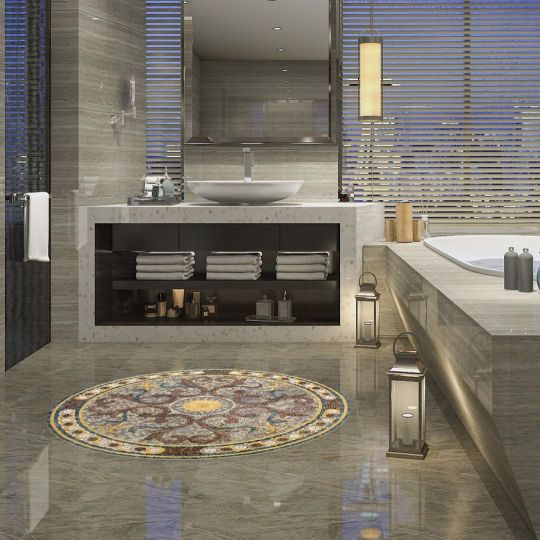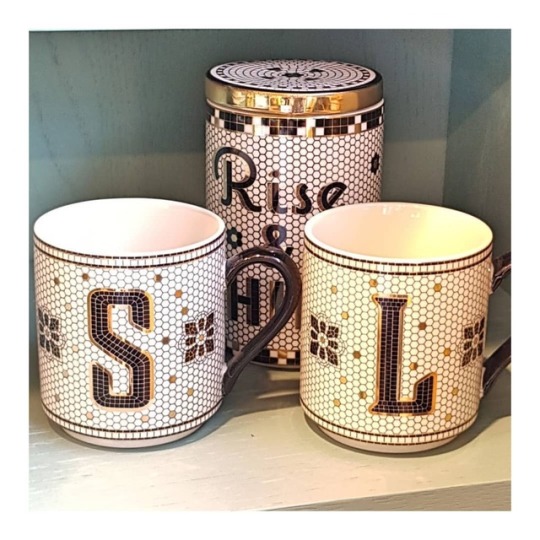#mosaicpattern
Explore tagged Tumblr posts
Text

In art, everything starts with vision and passion. Here, in the creative process, pieces of mosaic become more than just fragments – they form a whole, full of colors, emotions, and meaning. 🌟
Every piece has its place, every detail tells its story. Sometimes chaos leads to beauty – that’s the magic of creation.
✨ What does the creative process mean to you? Share your thoughts in the comments!
#MosaicArt #CreativeProcess #ArtisticExpression #CreatingArt #Inspiration #ArtBlog #PassionForArt #ColorsOfLife
#art process#muralart#polishartist#artcommunity#artisticexpression#artistatwork#artoftheday#creativeprocess#artinprogress#instaart#mozaic#mozaik#daily art#mosaicart#mosaicdesign#handmade art#colorfulmosaic#artistic expression#tile art#art detail#creative arts#mosaicpattern#handcrafted#artlovers#artinspiration#artistry#mosaiccreation#passionforart
3 notes
·
View notes
Text

Sale is happening NOW at TheCrochetCouch.com!
No promo code needed, just have at least 5 patterns in your cart…go to checkout…and discount will apply automatically!
Whether you like C2C, Mosaic, Bobble Stitch, SC or TSS….we have them all!
#blackfridaysale#crochetpattern#crochetpatternsale#c2cpattern#mosaicpattern#bobblepattern#scpattern#tsspattern#crochet#graphgan#the crochet couch#c2c#c2c crochet#c2cgraph
3 notes
·
View notes
Text

Entry 2: Rituals and Reverence
As the evening deepened, the sound of heels clacking against the wall created this rhythmic beat that just echoed through the silence. We bowed our heads and did this reverent countdown: "Three, two, hello." It was like our secret handshake, this sisterhood bound by invisible threads.
Names floated around us like leaves in the wind: LSA, Willow, Gunner, Autumn, Hunter, Fergus, Luna, Ruby, Cooper, Rosie, Reed, Poppy, Eva. Each name had its own story, its own little universe. Eva. Eva. We kept repeating it, like a mantra or a spell.
#RitualsAndReverence#GaudiInspired#WhimsicalGathering#OrganicDesign#FlowingLines#VibrantColors#NatureInspired#MosaicPatterns#CurvedStructures#Connection#Sisterhood#ReverentCountdown#MagicalAtmosphere#OldRituals#LeavesInTheWind
0 notes
Text
51 TYPES OF WORLD FAMOUS SURFACE PATTERN DESIGN

Surface pattern design encompass a wide range of artistic and decorative techniques. Here are some common types of surface and pattern designs:

51 TYPES OF WORLD FAMOUS SURFACE PATTERN DESIGN LIST OF 51 SURFACE PATTERN DESIGN What are types of surface pattern design mostly used ? - Geometric Patterns: These patterns are based on geometric shapes such as squares, triangles, circles, or hexagons. They often feature repetitive arrangements and can be simple or complex. - Floral Patterns: Floral designs incorporate various types of flowers, leaves, vines, and other botanical elements. They can be realistic or stylized and are often used in textiles, wallpaper, and ceramics. - Paisley Patterns: Paisley is a teardrop-shaped motif with intricate designs and originated in Persian and Indian cultures. Paisley patterns are characterized by curved, abstract shapes and are commonly used in textiles. - Stripes and Checks: Stripes are straight lines of varying widths and colors, while checks consist of intersecting horizontal and vertical lines, forming a grid-like pattern. Both patterns are versatile and widely used in clothing, home decor, and graphic design. - Polka Dots: Polka dots are circular or oval shapes that are evenly spaced and repeated across a surface. They can be small or large, and the spacing and color combinations can vary. - Animal Prints: Animal prints mimic the patterns found on animal fur, such as leopard spots, zebra stripes, or snake scales. These patterns are often used in fashion and interior design to add a bold and exotic touch. - Abstract Patterns: Abstract designs are non-representational and can be composed of various shapes, lines, and colors. They are often open to interpretation and can create visually striking and dynamic surfaces. - Textured Patterns: Textured designs create a tactile or visual illusion of texture on a flat surface. Examples include wood grain, brickwork, marble veining, or woven textures. - Damask Patterns: Damask is a type of fabric characterized by elaborate, reversible patterns woven into a solid background. These patterns often feature intricate floral motifs and are commonly used in upholstery and drapery. - Ethnic and Cultural Patterns: These patterns draw inspiration from specific cultures and can include motifs and symbols associated with traditional art and craft techniques from around the world. - Digital and Pixel Art: Digital patterns are created using computer software and often feature pixelated designs or abstract compositions that are visually influenced by technology. - Chevron Patterns: Chevron patterns consist of V-shaped motifs arranged in a continuous, zigzagging pattern. They can be bold and graphic or more subtle, depending on the size and color scheme used. - Herringbone Patterns: Herringbone patterns feature a series of parallel lines that intersect at a 45-degree angle, creating a distinctive "V" or zigzag pattern. This pattern is commonly seen in textiles, flooring, and tile designs. - Tartan Patterns: Tartan patterns, also known as plaid, originated in Scottish culture and are characterized by a checked pattern formed by horizontal and vertical bands of different colors. Each tartan design represents a specific clan or region. - Ikat Patterns: Ikat is a dyeing technique used to create unique patterns on textiles. The design is achieved by resist-dyeing the threads before weaving, resulting in blurred, feathery edges and vibrant, abstract motifs. - Mosaic Patterns: Mosaic designs consist of small, colored tiles or pieces of glass, stone, or other materials arranged to create intricate patterns and images. Mosaic patterns are commonly found in architecture, artwork, and decorative objects. - Embroidered Patterns: Embroidery involves stitching decorative designs onto fabric or other materials using threads or yarns. These patterns can be elaborate and incorporate a wide variety of stitches and techniques. - Batik Patterns: Batik is a traditional dyeing technique in which patterns are created by applying wax to fabric, then dyeing the fabric, and finally removing the wax to reveal the design. Batik patterns often feature intricate motifs and are commonly used in textiles. - Patchwork Patterns: Patchwork is a technique that involves sewing together small fabric pieces of different colors and patterns to create a larger design. This technique is commonly used in quilts, garments, and home decor items. - Lace Patterns: Lace designs are delicate, openwork patterns created by weaving or knitting threads together. Lace patterns are commonly used in textiles, fashion, and decorative accents. - Tribal Patterns: Tribal designs draw inspiration from indigenous cultures and feature bold, geometric shapes, and symbols. These patterns often carry cultural significance and are used in various art forms, textiles, and accessories. - Tie-Dye Patterns: Tie-dye is a technique that involves folding, twisting, or tying fabric before dyeing it to create unique, vibrant patterns. Tie-dye patterns are often characterized by concentric circles, spirals, or irregular bursts of color. - Chinoiserie Patterns: Chinoiserie is a European artistic style that imitates or incorporates elements of Chinese art and design. Chinoiserie patterns often feature exotic landscapes, pagodas, dragons, and stylized flora and fauna. - Abstract Expressionism: Abstract expressionism is a style of art that emphasizes spontaneous, gestural brushwork and non-representational compositions. Abstract expressionist patterns can be characterized by bold, energetic strokes, drips, and splatters. - Pop Art Patterns: Pop art emerged in the 1950s and 1960s, featuring vibrant colors, bold graphic elements, and popular culture references. Pop art patterns often include repeated imagery from advertisements, comic books, and everyday objects. - Art Deco Patterns: Art Deco originated in the 1920s and 1930s, known for its geometric shapes, streamlined forms, and luxurious materials. Art Deco patterns often feature stylized motifs such as fans, sunbursts, and chevrons. - Optical Illusion Patterns: Optical illusion patterns are designed to create visual effects that trick the viewer's perception. These patterns often utilize geometric shapes, contrasting colors, and precise arrangements to create the illusion of movement or dimension. - Scandinavian Patterns: Scandinavian design is known for its simplicity, clean lines, and organic forms. Scandinavian patterns often incorporate nature-inspired motifs, such as trees, leaves, and animals, and use a limited color palette. - Islamic Patterns: Islamic art and design feature intricate geometric patterns and arabesque motifs. These patterns are often symmetrical and repetitive, and they can be found in architecture, textiles, and decorative arts. - Retro Patterns: Retro patterns draw inspiration from past eras, such as the 1950s, 1960s, and 1970s. They often include bold colors, geometric shapes, and psychedelic or kitschy elements that evoke a nostalgic vibe. - Graffiti Patterns: Graffiti art incorporates bold, stylized lettering, images, and symbols often found in urban environments. Graffiti patterns can be colorful, expressive, and dynamic, reflecting the vibrant energy of street art. - Camouflage Patterns: Camouflage patterns are designed to blend into or disrupt the appearance of the surrounding environment. These patterns often consist of irregular shapes and a combination of colors to create a visually disruptive effect. - Moroccan Patterns: Moroccan design is characterized by intricate geometric patterns, vibrant colors, and ornate details. Moroccan patterns often feature interlocking shapes such as stars, hexagons, and octagons. - Scandinavian Folk Patterns: Scandinavian folk art often features stylized flora, fauna, and human figures in intricate patterns. These designs are known for their simplicity, flat shapes, and cheerful color schemes. - Abstract Organic Patterns: Abstract organic patterns are inspired by natural forms, such as flowing water, clouds, or organic textures. They often incorporate fluid lines, curvilinear shapes, and soft color palettes. - Tribal Tattoo Patterns: Tribal tattoo patterns draw inspiration from traditional tattoo art of indigenous cultures. These designs often feature bold, black ink lines and abstract motifs with cultural significance. - Victorian Patterns: Victorian design emerged during the reign of Queen Victoria in the 19th century and is characterized by ornate details, intricate flourishes, and rich textures. Victorian patterns often feature motifs like scrolls, floral elements, and damask designs. - Marbling Patterns: Marbling is a technique that creates unique and swirling patterns on surfaces such as paper, fabric, or ceramics. It involves floating pigments on a liquid surface and transferring the design onto the desired material. - Gingham Patterns: Gingham is a checkered pattern consisting of evenly spaced, colored squares, typically in two contrasting colors. Gingham patterns are commonly used in textiles, especially for tablecloths, clothing, and home decor. - Stained Glass Patterns: Stained glass designs are created by assembling colored glass pieces to form intricate patterns or images. These patterns are often found in windows, lamps, and decorative art, with the vibrant colors being illuminated by light. - Moroccan Tile Patterns: Moroccan tiles are known for their geometric shapes and intricate patterns. These tiles often feature a combination of colorful designs, such as stars, crosses, and interlocking motifs, and are commonly used in interior and architectural design. - Rorschach Inkblot Patterns: Rorschach inkblot patterns are created by folding a piece of paper with ink or paint and then opening it to reveal a symmetrical, abstract shape. These patterns often evoke imagination and interpretation. - Shibori Patterns: Shibori is a Japanese tie-dye technique that creates unique patterns on fabric. It involves folding, twisting, binding, or compressing fabric before dyeing it, resulting in various resist-dye patterns such as stripes, circles, or irregular shapes. - Celtic Knotwork Patterns: Celtic knotwork designs are intricate patterns composed of interwoven lines forming endless loops and knots. These patterns are associated with Celtic culture and are often found in jewelry, manuscripts, and decorative arts. - Art Nouveau Patterns: Art Nouveau emerged in the late 19th and early 20th centuries, featuring organic and flowing lines inspired by natural forms. Art Nouveau patterns often include floral motifs, elegant curves, and stylized depictions of plants and animals. - Islamic Calligraphy Patterns: Islamic calligraphy is an art form that utilizes Arabic script to create intricate patterns and designs. These patterns often incorporate verses from the Quran or religious phrases, and they can be found in various Islamic art forms. - Pixel Art Patterns: Pixel art involves creating images and patterns using small, square pixels. This style is often associated with retro video games and features blocky, pixelated designs with limited color palettes. - Op Art Patterns: Op art, short for optical art, is an art movement that uses geometric shapes and contrasting colors to create visual illusions of movement or depth. Op art patterns often feature repetitive lines, curves, and patterns that appear to shift or vibrate. - Paisley Patterns: Paisley patterns originated in Persia and are characterized by teardrop-shaped motifs with intricate designs. These patterns often feature curved, abstract shapes and are commonly used in textiles and accessories. - Origami Patterns: Origami is the art of folding paper to create various shapes and forms. Origami patterns can include geometric shapes, animals, and objects, and they often require precise folding techniques. These additional types of pattern and surface designs add even more variety and artistic styles to the list, showcasing the diverse range of patterns found in different cultures, art movements, and craft techniques.
LIST OF 51 SURFACE PATTERN DESIGN

51 TYPES OF WORLD FAMOUS SURFACE PATTERN DESIGN
What are types of surface pattern design mostly used ?
Here's a list of 51 pattern designs: - Floral Patterns - Geometric Patterns - Paisley Patterns - Striped Patterns - Polka Dot Patterns - Chevron Patterns - Damask Patterns - Ikat Patterns - Animal Print Patterns - Abstract Patterns - Tribal Patterns - Ethnic Patterns - Herringbone Patterns - Tartan Patterns - Gingham Patterns - Camouflage Patterns - Mosaic Patterns - Toile Patterns - Plaid Patterns - Checkered Patterns - Houndstooth Patterns - Moroccan Patterns - Art Deco Patterns - Aztec Patterns - Navajo Patterns - Victorian Patterns - Ditsy Patterns - Watercolor Patterns - Marble Patterns - Tie-Dye Patterns - Batik Patterns - Ombre Patterns - Scandinavian Patterns - Paisley Patterns - Retro Patterns - Millefleur Patterns - Scandinavian Patterns - Islamic Patterns - Japanese Patterns - Chinese Patterns - Indian Patterns - African Patterns - Celtic Patterns - Baroque Patterns - Polynesian Patterns - Hawaiian Patterns - Scandinavian Patterns - Art Nouveau Patterns - Fretwork Patterns - Sashiko Patterns - Quatrefoil Patterns These pattern designs cover a wide range of styles and inspirations, suitable for various design applications in fashion, interior design, graphic design, and more. Each pattern design brings its own unique charm and aesthetic appeal, making them versatile choices for a multitude of creative projects. Macrosoft Surface laptop will be perfect for designing purposes. Read the full article
#AbstractPatterns#AnimalPrints#BatikPatterns#ChevronPatterns#DamaskPatterns#Design#DESIGNS#Digital#DigitalandPixelArt#EmbroideredPatterns#EthnicandCulturalPatterns#Floral#FloralPatterns#GeometricPatterns#Graphics#HerringbonePatterns#IkatPatterns#LacePatterns#MosaicPatterns#new#Paisley#PaisleyPatterns#PatchworkPatterns#Pattern#PolkaDots#StripesandChecks#Surface#TartanPatterns#TexturedPatterns#Tie-DyePatterns
0 notes
Photo

Handmade marble mosaic medallion for home decor
#mosaicnatural#mosaicmedallion#medallion#mosaicpattern#tabletop#mosaicwallart#flooringtile#floortile#interiordesign#handmademosaic#mosaicmural#mosaic#mosaicdesign#mosaictiles#wallart#poolmosaic#showermosaic#homedesigns#bathroomdesign
2 notes
·
View notes
Photo

My Molokai Shawl pattern designed for MissBabs book club is now available as individual download on @hi.ravelry 🧶 It's two color asymmetric triangular shael worked sideways in garter stitch with etelets and mosaic patterns. The yarn is absolutely lovely Yummy-3ply by @missbabsyarns 😍 . #MolokaiShawl #otrutadesign #tetianaotruta #shawlknitting #knittinginspiration #knittedshawl #mosaicpattern #knittingpattern #knitterslife #knitweardesigner #tetianaotruta_patterns #instaknitting https://www.instagram.com/p/B-Sqy35Agkc/?igshid=qi11gq1fghw3
#molokaishawl#otrutadesign#tetianaotruta#shawlknitting#knittinginspiration#knittedshawl#mosaicpattern#knittingpattern#knitterslife#knitweardesigner#tetianaotruta_patterns#instaknitting
6 notes
·
View notes
Photo

The last three mosaic images posted all use a knotwork border. Traditionally known as guilloche (actually an 18th century French term) these intertwining rope patterns were used extensively in Roman floor mosaics across the whole Roman world. The basic pattern is of two strands, but there are many variants, the one in this picture is a three strand guilloche being constructed in the studio. But there is also four, five and six strands or more as well as other looped back variations. The beauty of them from a mosaic makers point of view is they appear incredibly intricate and elaborate but there construction, and the amount of cutting involved, is relatively simple. One thing those Roman mosaic makers really knew was how to create incredible mosaics in the most economic way. #mosaic #guilloche #romanmosaic #mosaicpattern #knotwork #ropepattern #mosaiccraft https://www.instagram.com/p/Bxvies5gXAL/?igshid=1acnjiozuapec
1 note
·
View note
Photo

COFFEE • BREAK • TIME ☕ We'll have ours in these please... . . . . . #muglove #coffeetime #timeforabreak #flatwhite #vegan #plantbased #coffee #afternoonbreak #blackandgold #coffeebreak #mosaicpattern #iwantoneofthose https://www.instagram.com/p/Bul3SfblQAw/?utm_source=ig_tumblr_share&igshid=aprtdm2e5zf5
#muglove#coffeetime#timeforabreak#flatwhite#vegan#plantbased#coffee#afternoonbreak#blackandgold#coffeebreak#mosaicpattern#iwantoneofthose
1 note
·
View note
Photo

CrafTreat Mosaic Pattern textured Decoupage Paper Design can give life to your plain surface, one paper multiple uses like wrapping paper, collage papers, Decoupage furniture, Tray, Glass, Vase and more.
0 notes
Link
Dark Granite Mosaic Plaza and Garden Floor Pattern Tiles
Natural Granite Mosaic pattern stone designs consist of irregular pieces of natural stone for siding, facing, and cladding. The shapes consist primarily of triangles and stop sign shapes and the pattern is similar to the mosaic dimensions created from broken or small pcs of granite stone. Esta Stone produces and exports an extensive selection of natural stone and pebbles for residential and commercial use. We specialize in unique product lines, using the highest quality natural stone.
Natural stone mosaic tiles are a great way to add depth and dimension to homes and commercial building projects, like a hotel lobby, Mall atrium, and office building entrance floor. The mosaic tiles are easy to clean and maintain. They are stain and moisture-resistant and very durable. Stone mosaic tiles are versatile and come in a variety of colors, materials, and price points, ensuring that there is something for every taste and budget. connect us at [email protected]
0 notes
Photo

Glitch pattern - kind of a psychadelic mosaic.
#glitch#numeric art#glitch aesthetic#tumblr art blogs#Glitch Artists Collective#glitch artist#made by my computer#pattern#tumblr aesthetic#art#vaporwave#vaporwave art#mosaic#mosaicpattern#psychadelic#miror
2 notes
·
View notes
Text

The Eagle Flying Afghan is worked up in overlay mosaic and a gorgeous addition to your décor! 🦅 🦅 ~ Pattern available at: https://thecrochetcouch.com/overlay-mosaic/eagle-flying
#eagleafghanpattern#eagleafghan#eaglecrochetafghan#mosaicpatterns#OverlayMosaicCrochet#OverlayMosaicCrochetPatterns#crochet pattern#crochet#the crochet couch
4 notes
·
View notes
Photo

Well we are growing but not fast enough. #mosaic #mosaiccrochet #mosaicblanket #mosaicblankets #loveunspokenblankets #crochetblanket #crochetblankets #mosaicpattern #makersgonnamake #loveunspoken #loveunspokenllc #etsyshop #etsysellersofinstagram #etsycrochet #etsycrochetshop #etsyloveunspokencrochet https://www.instagram.com/p/CIP74h6BrWB/?igshid=j5ff9qfwujws
#mosaic#mosaiccrochet#mosaicblanket#mosaicblankets#loveunspokenblankets#crochetblanket#crochetblankets#mosaicpattern#makersgonnamake#loveunspoken#loveunspokenllc#etsyshop#etsysellersofinstagram#etsycrochet#etsycrochetshop#etsyloveunspokencrochet
0 notes
Text
TYPES OF PATTERN AND SURFACE DESIGN

Pattern and surface design encompass a wide range of artistic and decorative techniques. Here are some common types of pattern and surface designs: - Geometric Patterns: These patterns are based on geometric shapes such as squares, triangles, circles, or hexagons. They often feature repetitive arrangements and can be simple or complex. - Floral Patterns: Floral designs incorporate various types of flowers, leaves, vines, and other botanical elements. They can be realistic or stylized and are often used in textiles, wallpaper, and ceramics. - Paisley Patterns: Paisley is a teardrop-shaped motif with intricate designs and originated in Persian and Indian cultures. Paisley patterns are characterized by curved, abstract shapes and are commonly used in textiles. - Stripes and Checks: Stripes are straight lines of varying widths and colors, while checks consist of intersecting horizontal and vertical lines, forming a grid-like pattern. Both patterns are versatile and widely used in clothing, home decor, and graphic design. - Polka Dots: Polka dots are circular or oval shapes that are evenly spaced and repeated across a surface. They can be small or large, and the spacing and color combinations can vary. - Animal Prints: Animal prints mimic the patterns found on animal fur, such as leopard spots, zebra stripes, or snake scales. These patterns are often used in fashion and interior design to add a bold and exotic touch. - Abstract Patterns: Abstract designs are non-representational and can be composed of various shapes, lines, and colors. They are often open to interpretation and can create visually striking and dynamic surfaces. - Textured Patterns: Textured designs create a tactile or visual illusion of texture on a flat surface. Examples include wood grain, brickwork, marble veining, or woven textures. - Damask Patterns: Damask is a type of fabric characterized by elaborate, reversible patterns woven into a solid background. These patterns often feature intricate floral motifs and are commonly used in upholstery and drapery. - Ethnic and Cultural Patterns: These patterns draw inspiration from specific cultures and can include motifs and symbols associated with traditional art and craft techniques from around the world. - Digital and Pixel Art: Digital patterns are created using computer software and often feature pixelated designs or abstract compositions that are visually influenced by technology. - Chevron Patterns: Chevron patterns consist of V-shaped motifs arranged in a continuous, zigzagging pattern. They can be bold and graphic or more subtle, depending on the size and color scheme used. - Herringbone Patterns: Herringbone patterns feature a series of parallel lines that intersect at a 45-degree angle, creating a distinctive "V" or zigzag pattern. This pattern is commonly seen in textiles, flooring, and tile designs. - Tartan Patterns: Tartan patterns, also known as plaid, originated in Scottish culture and are characterized by a checked pattern formed by horizontal and vertical bands of different colors. Each tartan design represents a specific clan or region. - Ikat Patterns: Ikat is a dyeing technique used to create unique patterns on textiles. The design is achieved by resist-dyeing the threads before weaving, resulting in blurred, feathery edges and vibrant, abstract motifs. - Mosaic Patterns: Mosaic designs consist of small, colored tiles or pieces of glass, stone, or other materials arranged to create intricate patterns and images. Mosaic patterns are commonly found in architecture, artwork, and decorative objects. - Embroidered Patterns: Embroidery involves stitching decorative designs onto fabric or other materials using threads or yarns. These patterns can be elaborate and incorporate a wide variety of stitches and techniques. - Batik Patterns: Batik is a traditional dyeing technique in which patterns are created by applying wax to fabric, then dyeing the fabric, and finally removing the wax to reveal the design. Batik patterns often feature intricate motifs and are commonly used in textiles. - Patchwork Patterns: Patchwork is a technique that involves sewing together small fabric pieces of different colors and patterns to create a larger design. This technique is commonly used in quilts, garments, and home decor items. - Lace Patterns: Lace designs are delicate, openwork patterns created by weaving or knitting threads together. Lace patterns are commonly used in textiles, fashion, and decorative accents. - Tribal Patterns: Tribal designs draw inspiration from indigenous cultures and feature bold, geometric shapes, and symbols. These patterns often carry cultural significance and are used in various art forms, textiles, and accessories. - Tie-Dye Patterns: Tie-dye is a technique that involves folding, twisting, or tying fabric before dyeing it to create unique, vibrant patterns. Tie-dye patterns are often characterized by concentric circles, spirals, or irregular bursts of color. - Chinoiserie Patterns: Chinoiserie is a European artistic style that imitates or incorporates elements of Chinese art and design. Chinoiserie patterns often feature exotic landscapes, pagodas, dragons, and stylized flora and fauna. - Abstract Expressionism: Abstract expressionism is a style of art that emphasizes spontaneous, gestural brushwork and non-representational compositions. Abstract expressionist patterns can be characterized by bold, energetic strokes, drips, and splatters. - Pop Art Patterns: Pop art emerged in the 1950s and 1960s, featuring vibrant colors, bold graphic elements, and popular culture references. Pop art patterns often include repeated imagery from advertisements, comic books, and everyday objects. - Art Deco Patterns: Art Deco originated in the 1920s and 1930s, known for its geometric shapes, streamlined forms, and luxurious materials. Art Deco patterns often feature stylized motifs such as fans, sunbursts, and chevrons. - Optical Illusion Patterns: Optical illusion patterns are designed to create visual effects that trick the viewer's perception. These patterns often utilize geometric shapes, contrasting colors, and precise arrangements to create the illusion of movement or dimension. - Scandinavian Patterns: Scandinavian design is known for its simplicity, clean lines, and organic forms. Scandinavian patterns often incorporate nature-inspired motifs, such as trees, leaves, and animals, and use a limited color palette. - Islamic Patterns: Islamic art and design feature intricate geometric patterns and arabesque motifs. These patterns are often symmetrical and repetitive, and they can be found in architecture, textiles, and decorative arts. - Retro Patterns: Retro patterns draw inspiration from past eras, such as the 1950s, 1960s, and 1970s. They often include bold colors, geometric shapes, and psychedelic or kitschy elements that evoke a nostalgic vibe. - Graffiti Patterns: Graffiti art incorporates bold, stylized lettering, images, and symbols often found in urban environments. Graffiti patterns can be colorful, expressive, and dynamic, reflecting the vibrant energy of street art. - Camouflage Patterns: Camouflage patterns are designed to blend into or disrupt the appearance of the surrounding environment. These patterns often consist of irregular shapes and a combination of colors to create a visually disruptive effect. - Moroccan Patterns: Moroccan design is characterized by intricate geometric patterns, vibrant colors, and ornate details. Moroccan patterns often feature interlocking shapes such as stars, hexagons, and octagons. - Scandinavian Folk Patterns: Scandinavian folk art often features stylized flora, fauna, and human figures in intricate patterns. These designs are known for their simplicity, flat shapes, and cheerful color schemes. - Abstract Organic Patterns: Abstract organic patterns are inspired by natural forms, such as flowing water, clouds, or organic textures. They often incorporate fluid lines, curvilinear shapes, and soft color palettes. - Tribal Tattoo Patterns: Tribal tattoo patterns draw inspiration from traditional tattoo art of indigenous cultures. These designs often feature bold, black ink lines and abstract motifs with cultural significance. - Victorian Patterns: Victorian design emerged during the reign of Queen Victoria in the 19th century and is characterized by ornate details, intricate flourishes, and rich textures. Victorian patterns often feature motifs like scrolls, floral elements, and damask designs. - Marbling Patterns: Marbling is a technique that creates unique and swirling patterns on surfaces such as paper, fabric, or ceramics. It involves floating pigments on a liquid surface and transferring the design onto the desired material. - Gingham Patterns: Gingham is a checkered pattern consisting of evenly spaced, colored squares, typically in two contrasting colors. Gingham patterns are commonly used in textiles, especially for tablecloths, clothing, and home decor. - Stained Glass Patterns: Stained glass designs are created by assembling colored glass pieces to form intricate patterns or images. These patterns are often found in windows, lamps, and decorative art, with the vibrant colors being illuminated by light. - Moroccan Tile Patterns: Moroccan tiles are known for their geometric shapes and intricate patterns. These tiles often feature a combination of colorful designs, such as stars, crosses, and interlocking motifs, and are commonly used in interior and architectural design. - Rorschach Inkblot Patterns: Rorschach inkblot patterns are created by folding a piece of paper with ink or paint and then opening it to reveal a symmetrical, abstract shape. These patterns often evoke imagination and interpretation. - Shibori Patterns: Shibori is a Japanese tie-dye technique that creates unique patterns on fabric. It involves folding, twisting, binding, or compressing fabric before dyeing it, resulting in various resist-dye patterns such as stripes, circles, or irregular shapes. - Celtic Knotwork Patterns: Celtic knotwork designs are intricate patterns composed of interwoven lines forming endless loops and knots. These patterns are associated with Celtic culture and are often found in jewelry, manuscripts, and decorative arts. - Art Nouveau Patterns: Art Nouveau emerged in the late 19th and early 20th centuries, featuring organic and flowing lines inspired by natural forms. Art Nouveau patterns often include floral motifs, elegant curves, and stylized depictions of plants and animals. - Islamic Calligraphy Patterns: Islamic calligraphy is an art form that utilizes Arabic script to create intricate patterns and designs. These patterns often incorporate verses from the Quran or religious phrases, and they can be found in various Islamic art forms. - Pixel Art Patterns: Pixel art involves creating images and patterns using small, square pixels. This style is often associated with retro video games and features blocky, pixelated designs with limited color palettes. - Op Art Patterns: Op art, short for optical art, is an art movement that uses geometric shapes and contrasting colors to create visual illusions of movement or depth. Op art patterns often feature repetitive lines, curves, and patterns that appear to shift or vibrate. - Paisley Patterns: Paisley patterns originated in Persia and are characterized by teardrop-shaped motifs with intricate designs. These patterns often feature curved, abstract shapes and are commonly used in textiles and accessories. - Origami Patterns: Origami is the art of folding paper to create various shapes and forms. Origami patterns can include geometric shapes, animals, and objects, and they often require precise folding techniques. These additional types of pattern and surface designs add even more variety and artistic styles to the list, showcasing the diverse range of patterns found in different cultures, art movements, and craft techniques. Read the full article
#AbstractPatterns#AnimalPrints#BatikPatterns#ChevronPatterns#DamaskPatterns#Design#DESIGNS#Digital#DigitalandPixelArt#EmbroideredPatterns#EthnicandCulturalPatterns#Floral#FloralPatterns#GeometricPatterns#Graphics#HerringbonePatterns#IkatPatterns#LacePatterns#MosaicPatterns#new#Paisley#PaisleyPatterns#PatchworkPatterns#Pattern#PolkaDots#StripesandChecks#Surface#TartanPatterns#TexturedPatterns#Tie-DyePatterns
1 note
·
View note
Photo

Sea Creatures Scene Marble Mosaic Art Design
#mosaicnatural#mosaicmedallion#medallion#mosaicpattern#tabletop#mosaicwallart#flooringtile#floortile#interiordesign#handmademosaic#mosaicmural#mosaic#mosaicdesign#mosaictiles#wallart#poolmosaic#showermosaic#homedesigns#bathroomdesign
0 notes
Photo

Finally I can show the design I've kept in secret for a long time 😊 Meet Molokai Shawl inspired by Moloka'i by Alan Brennet book exclusively designed for Miss Babs Book Club @missbabsyarns . It's a two color asymmetric triangular shawl worked sideways in garter stitch with mosaic pattern and eyelet sections. . Have you ever read this book? Do you want me to share a story how my impression of the book was transformed into this design? . #MolokaiShawl #missbabsbookclub2019 #otrutadesign #knittedshawl #knitpattern #knitdesign #mosaicpattern #knitaddict #knittinginspiration #instaknitter https://www.instagram.com/p/B3aLq8Dg9fo/?igshid=rnve9ufpciah
#molokaishawl#missbabsbookclub2019#otrutadesign#knittedshawl#knitpattern#knitdesign#mosaicpattern#knitaddict#knittinginspiration#instaknitter
4 notes
·
View notes